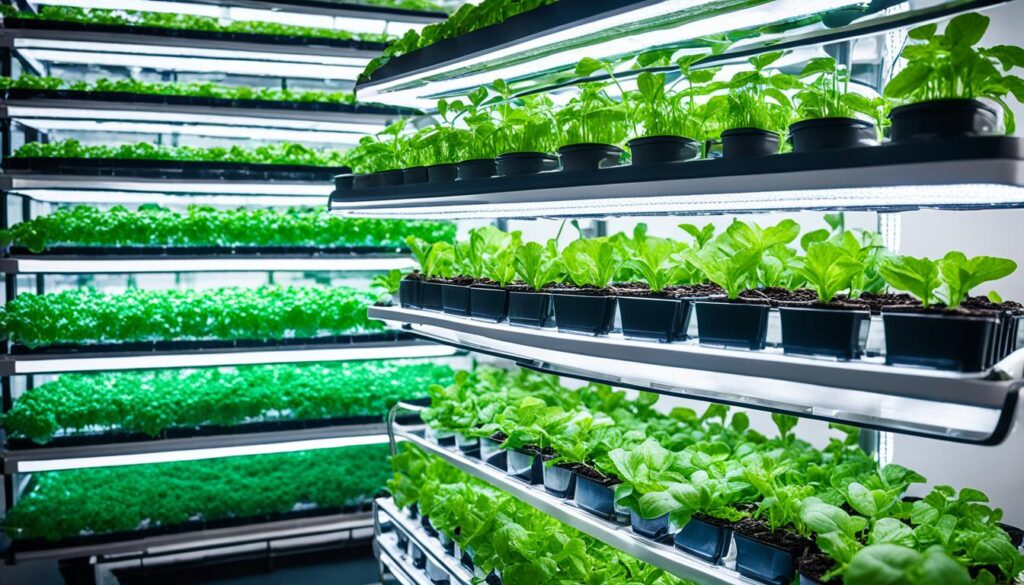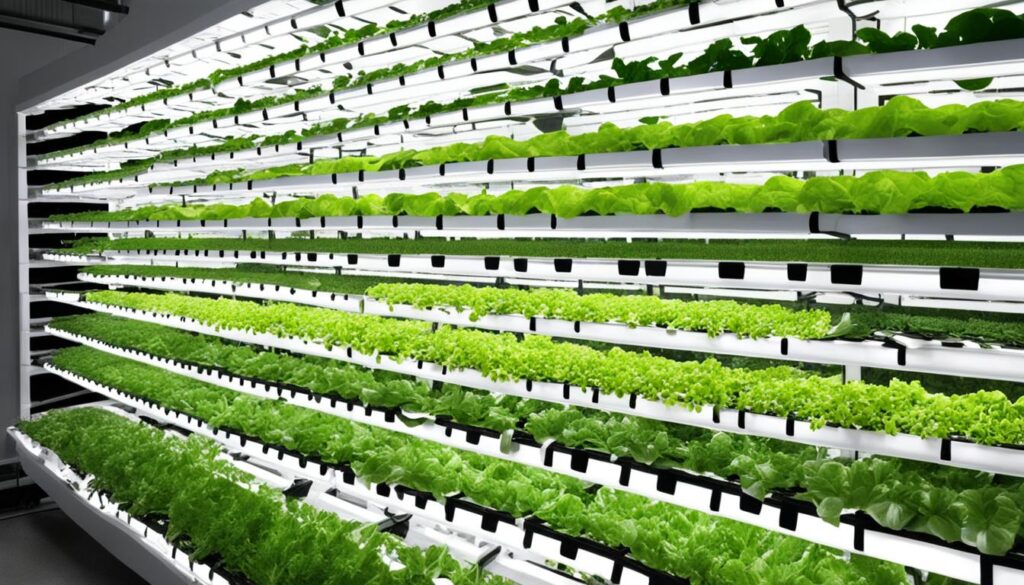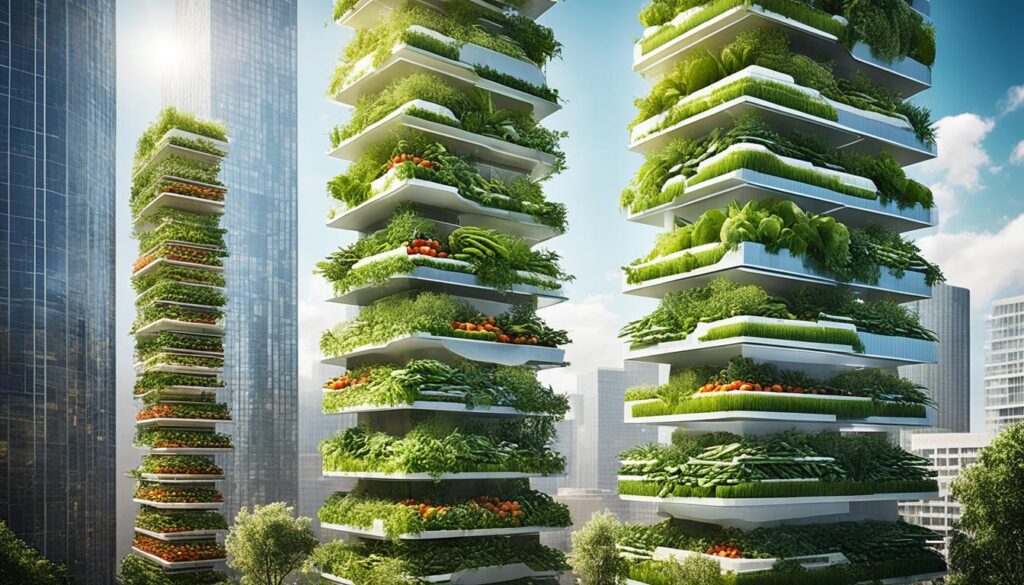Vertical farming is a new and green way to grow food. It tackles big issues like more people, towns taking over nature, and the changing climate. It shows both the good and not so good sides of vertical farming. You’ll read about how it saves space, makes crops all year, saves water, helps the planet, is healthy, and makes cities better. But, it also points out its hard parts like the big costs to start, use a lot of energy, is tough to get bigger, and not growing a lot of different crops. This story will help everyone get why vertical farming matters now and in the future.
Key Takeaways
- Vertical farming uses less space in crowded cities.
- It grows crops all the time with better nutrients.
- It saves water by not using as much as usual farming.
- But, it costs a lot to begin and to keep running, and uses a bunch of energy.
- It’s hard to make vertical farming big and to grow some plants in it.
Understanding Vertical Farming
Vertical farming is a new way to grow food. Farmers plant crops in many stacked layers. This is done inside a building, not on a big field. This new way of farming is now found in many cities all over the world.
What is Vertical Farming?
Vertical farming is like farming inside a high building. It uses special ways to grow plants, not soil. This is great for crowded cities since there is not much land for farming.
The Evolution of Vertical Farming
People have known about vertical farming for a long time. It has become very popular in the last few years because more people are living in cities. By 2050, there will be over 9 billion people on the planet. Most of them will live in cities.
Vertical farming helps make sure there is enough food for everyone. It also helps the environment. That’s why more and more farmers are doing it this way.
Technological Advancements in Vertical Farming
Vertical farming is getting better all the time. New technology like LED lighting and automation make things easier. Farms are more efficient and cheaper to run now.
Crops like fruits and vegetables can be grown this way. It’s good for the earth too. This kind of farming doesn’t harm the planet as much as normal farming does.

The Pros of Vertical Farming
Vertical farming is great for many reasons. It uses space very well. This means more crops grown in small areas, perfect for cities.
Year-Round Crop Production
Vertical farms can grow food all the time. They use indoor spaces to control the weather. This gives us fresh veggies whenever we want.
Water Conservation
Vertical farms use less water than usual farms, up to 95% less. This is good for places with not much water. It also helps fight climate change.
Reduced Environmental Impact
Vertical farming is better for Earth than normal farming. It doesn’t need as many chemicals or make as much waste. This helps our planet.
Nutritional Benefits
Some ways of vertical farming make really healthy food. They add lots of vitamins and minerals. So, we get better food from these farms.
Urban Renewal and Food Security
Vertical farming can help make cities better. It brings food closer to people. This means less pollution from moving food far, and fresh food for everyone.

Pros and Cons of Vertical Farming
Vertical farming is becoming more popular for good reasons. It uses less space and grows food all year. But it can be expensive and uses a lot of energy. So, it’s both great and hard at the same time.
| Pros of Vertical Farming | Cons of Vertical Farming |
|---|---|
|
|
The world’s population is getting bigger. By 2050, the United Nations thinks we’ll have 2.2 billion more people. Most will live in cities. This means we need more ways to grow food well in small places. Vertical farming is one solution. We’re always finding new ways to make it better
The Cons of Vertical Farming
Vertical farming has many good points. But, there are also cons to think about. One big issue is the high startup and operational costs. This farming needs special tools like LED lights and climate systems. It also needs hydroponic or aeroponic systems which cost a lot. Taking care of this equipment and making sure it’s up-to-date also costs a lot.
The high energy consumption in vertical farming stands out. It takes a lot of energy to keep the right climate and light indoors. This might make it less green than normal farming. Regular farms use the sun and rain to grow crops.
Getting bigger in vertical farming is not easy. As farms get larger, managing the logistics, automation, and labor requirements is hard. This can stop them from growing to save money.
Also, limited crop diversity is a big worry. Vertical farms can’t grow as many different crops as the fields. This makes it hard to replace crops like soy beans, wheat, and other protein-dense plants. So, the food from these farms might not have a wide variety of nutrients.
| Cons of Vertical Farming | Impact |
|---|---|
| High Startup Costs | Significant initial investment required for specialized equipment and climate-controlled infrastructure |
| High Operational Costs | Ongoing monitoring, maintenance, and equipment upgrades contribute to elevated operational expenses |
| High Energy Consumption | Controlled climate and lighting systems can make vertical farming less sustainable compared to traditional farming |
| Scaling Up Challenges | Difficulty in managing logistics, automation, and labor requirements as vertical farms grow in size and complexity |
| Limited Crop Diversity | Hydroponic systems may only support a limited number of crops, making it difficult to replace the farming of tall field crops like soy beans, wheat, and other protein-dense plants |
The Future of Vertical Farming
The vertical farming world is getting better all the time. New technological innovations are leading the charge. They promise to offer sustainable solutions while blending well into city life.
Technological Innovations
New LED technology and smart AI and machine learning are changing farming. They save energy, boost crop growth, and cut costs. Thanks to new pollination techniques, crops stay healthy even without bees’ direct help.
Sustainable Solutions
Vertical farming can help with our need for a greener earth. It uses closed-loop systems and needs less space. This means it saves water, protects the surrounding tall crops and soy beans, and helps in creating food more sustainably.
Urban Integration
Vertical farms are moving into our cities fast. They bring food closer to home, cutting down trips that harm the environment. They also make new jobs, asking for people with skills to look after these high-tech farms.
Conclusion
Vertical farming is a new way of farming that helps the planet. It tackles big issues like more people, growing cities, and changes in the weather. This article looked deep into the good and bad of vertical farming, showing both sides clearly.
Vertical farming brings many benefits. It saves a lot of space, lets farmers grow crops all year, uses less water, and does little harm to the earth. It’s also good for health, makes cities nicer, and helps keep food secure. But, starting up and running can be costly. It uses more energy, needs to get bigger, and doesn’t offer as many types of crops.
The vertical farming world keeps getting better. New tech and ways to use the land well give hope. We now see how to fit it into cities nicely. Understanding the good and the not-so-good of vertical farming helps everyone make it work well. This way, we can use its full strength for good as a smart farming way in cities and indoor places.

